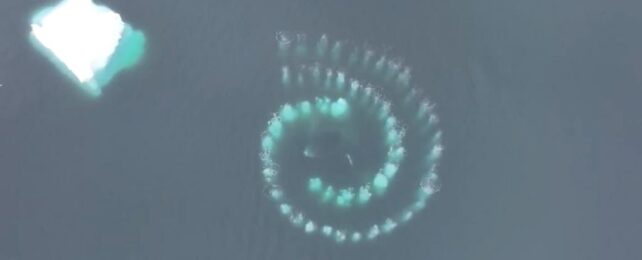Professional photographer and polar guide, Piet van den Bemd, was flying a drone across the dark blue waters of the Antarctic when his camera caught sight of an emerging pattern, rising from the deep.
The unfurling coil of light blue bubbles created a shape on the ocean surface that looked remarkably like a Fibonacci spiral – the famous mathematical pattern that often appears in the natural world, from plant to animal life.
Only when the spiral was complete did van den Bemd realize what had made it.
From the center of the pattern, rose two gigantic mouths, wide open for feeding.
They were humpback whales.

Van den Bemd told the news agency, Storyful, that it's a moment he will never forget. "The Fibonacci spiral shape executed perfectly made it incredible," he said.
For more than thirty years researchers have recognized humpback whales use bubbles as a form of tool. Sometimes, the bubbles are apparently used to intimidate rivals, whereas other times, the whales blow huge 'walls' of bubbles that confine fish and krill into ever tighter spaces.
This latter strategy is called bubble-net feeding, and it relies on careful cooperation between two or more humpbacks.
On Instagram, Van den Bemd described the hunting trick as "nature's perfect collaboration unfolds beneath the waves", and it's hard to disagree.
While some view Fibonacci shapes in nature as the result of some deeper form of efficiency, in cases like this the shape is merely a tight spiral, one likely the result of well-practiced timing. Not that it makes it any less beautiful.
Bubble-net feeding relies on whales diving deep below the surface and aiming their bubbles upwards in synchrony. One whale is usually the lead bubble blower, while the others swim around the fish and herd them into the temporary trap.
Once the prey are tightly gathered, the whales open their mouths wide and start gulping, usually charging through the eye of the spiral.
The behavior appears to be culturally learned, but because of the elusive lives of humpbacks, it is rarely captured on film. To date, it has mostly been cataloged among whale populations in the Northern Hemisphere.

Citizen scientists with drones are now changing the conversation. Their bird's-eye-view footage is now providing scientists with a front row view of whale life like never before.
In the Southern Hemisphere, drones have revealed humpback whales bubble-net feeding several times in recent years.
In one case off the coast of eastern Australia, as many as 33 whales were seen partaking in the hunting behavior. Because the whales were in their breeding grounds, where it was thought they usually avoid feeding, the discovery has scientists questioning what they know about humpback migration behaviors.
There's still so much we don't yet understand about these highly intelligent creatures. Some naturalists who have seen whales blow bubbles on numerous occasions think that the behavior could even be a form of play.
Professional photojournalist, Doug Perrine, wrote for Hakai Magazine about a time he saw a young female humpback 'draw' a circle of bubbles in the water around her.
"There was no food around and no other whales in sight," he recalled in the piece.
"She rolled to one side so that she could look upward to admire her handiwork. Was she practicing making bubble structures that could be useful tools on the feeding grounds, or was she just enjoying the visual beauty of the scintillating bubble spirals?"
Maybe one day we will know the answer.
